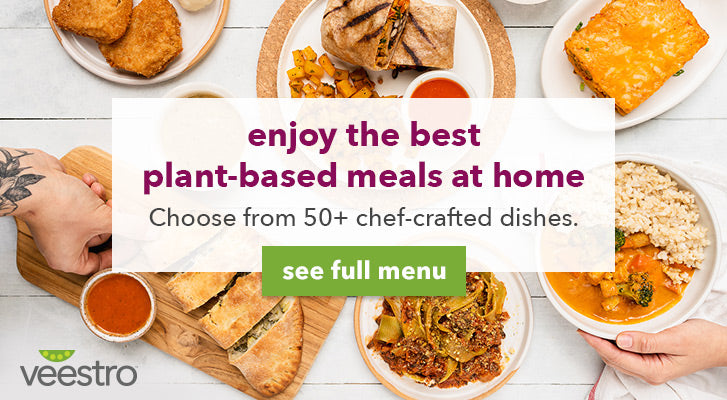10 tips for going plant-based
You've sifted through food articles, the Veestro blog, scientific studies, and even controversies, and you've finally decided to go plant-based. Suddenly it seems you're venturing into totally new territory- different meal planning, recipes, flavors, nutrition, and caloric values. Where do you even start?
Try these 10 tips for a seamless transition. Gradually, new habits will replace the old, and in time, the positive results may inspire you toward a full-fledged, plant-based lifestyle.
1. Fix Your Own Favorites More OftenGood news! You’re already halfway to your goal, because the truth is, you’ve always prepared plant foods—maybe a caprese salad, Buddha bowl, or pizza margherita and assorted side dishes. Just dust off your recipe box and rotate the plant-based recipes back onto your plate more often. After all, they’re tried-and-true favorites you already love.
2. Break Open the Cookbooks
Take time to browse through your cookbooks for plant-food ideas, or click through the online recipes at Plant-Based Cooking, Center for Nutrition Studies, and Tastemade for inspiring meals. Or head down to the local health-food store to explore.
3. Stock Up on Plant-Based Snacks
It’s as easy to grab an energy bar as it is a candy bar. Keep tasty veggie snacks in the kitchen and kids’ lunchboxes—fruits, nuts, raw vegetables, bean soup, and nut butters or hummus on whole-grain crackers. For a quick breakfast, blend a soy smoothie.
Read more about high fiber foods you can snack on.
4. Sip Smoothies
Don’t want to cook? Eating on the go? Smoothies provide a simple solution, and are packed with fiber, antioxidants, protein, and healthy fats—all blended in one delicious meal.
5. Do Meatless Monday
Mondays represent new beginnings. Join the global Meatless Monday movement, and launch your personal plant-based campaign.
Read more about why you should participate in Meatless Monday.
6. Pick Plant Proteins
Plant proteins are better for you. Tempeh, edamame beans, and tofu are excellent high-protein substitutes for nonveg sources. Want to eliminate eggs from your diet too? Try plant-based egg replacements.
Read more about why plant-based protein is better for you.
7. Reduce (or Drop) Dairy
For drinking and cooking, replace cow milk with plant milk. You’ll get all the calcium and protein you need, plus vitamins and minerals. Non-dairy products like soy, almond, and rice milks are especially nutrient-rich.
Read more about 5 simple ways to cut out dairy.
8. Love Legumes
The multi-talented legumes (beans, lentils, peas) are high in fiber, carbs, protein, vitamins, and minerals. So let them play a starring role at your table for substantial, satisfying meals that won’t let you walk away feeling hungry.
9. Add Grains, Seeds, and Roots
The plethora of protein-rich grains (wheat, oats, barley) and seeds (flax, sunflower, sesame) found in whole-grain pastas, seedy breads, and rustic desserts provide the best sources for protein, carbs, and healthy fats. Gluten-free? Root vegetables are an awesome alternative. Replace white potatoes with nutrient-dense sweet potatoes and yams, and don’t forget roots like turnips, beets and, of course, carrots.
10. Make Life Easier!
Have a gourmet chef help with the cooking—add Veestro plant-based meal delivery to your plan, and make your transition even easier. Convenient meal plans and weight-loss plans bring you balanced, organic, plant-based dishes to simply heat and eat.
Sources:Leslie Beck, Tips for Making the Switch to a Plant-Based Diet,
The Globe and MailVera Churilov, Plant-Based Diet for Beginners: How to Get Started,
MBGEva Lantsoght, How to Switch to a Plant-Based Diet, PhD Talk![]()

